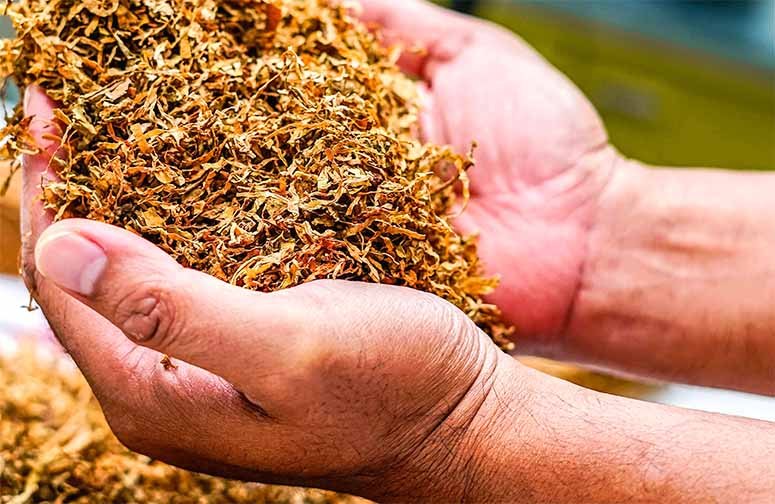Contents
- 1 What is chewing tobacco?
- 2 How does chewing tobacco increase the risk of cancer?
- 3 What are the types of cancer associated with chewing tobacco?
- 4 What are the symptoms of chewing tobacco-related cancer?
- 5 What are the odds of developing cancer from chewing tobacco?
- 6 How can you reduce the risk of cancer from chewing tobacco?
Chewing tobacco may appear to be a benign habit to some individuals – however, the reality is significantly more concerning.
This document examines the serious risks associated with chewing tobacco, with a particular focus on its correlation with various forms of cancer.
What are the odds of developing cancer from chewing tobacco? This article delves into that question by detailing the harmful chemicals found within chewing tobacco and acknowledging the symptoms and statistics related to cancers linked to its use.
Additionally, effective strategies for mitigating risk and promoting healthier choices are presented.
Continue reading to acquire knowledge that could prove to be life-saving.
What is chewing tobacco?
Chewing tobacco is a type of smokeless tobacco composed of shredded leaves that is typically retained between the gum and cheek for extended periods.
This tobacco product is available in several forms, including loose leaf, twist, and plug, and has gained popularity due to its perceived convenience and ease of use.
However, despite its widespread use, the health implications of chewing tobacco are considerable, prompting concerns regarding its impact on oral health as well as its contribution to nicotine addiction and other associated health risks.
How does chewing tobacco increase the risk of cancer?
Chewing tobacco substantially increases the risk of cancer for users, primarily due to the presence of tobacco carcinogens released during its consumption.
Consistent use of this form of smokeless tobacco has been associated with various tobacco-related cancers, particularly those affecting the oral cavity, esophagus, and pancreas.
The concerning cancer statistics indicate that individuals who utilize chewing tobacco encounter a significantly elevated risk of developing cancer types that can profoundly affect their quality of life, thereby underscoring the serious dangers associated with this habit.
What are the chemicals found in chewing tobacco?
 Chewing tobacco contains numerous harmful chemicals, including tobacco carcinogens such as nitrosamines, formaldehyde, and benzene, which are known to contribute to serious health issues.
Chewing tobacco contains numerous harmful chemicals, including tobacco carcinogens such as nitrosamines, formaldehyde, and benzene, which are known to contribute to serious health issues.
These chemicals can result in adverse effects associated with chewing tobacco, including oral lesions and gum disease, and are a fundamental aspect of the health warnings issued by medical professionals.
Understanding these compounds is essential for evaluating the risks associated with tobacco use.
These harmful chemicals are derived from both the tobacco plant itself and the additives incorporated during the manufacturing process.
For example, nitrosamines are generated when tobacco undergoes curing and fermentation, while formaldehyde often results as a byproduct of burning tobacco.
The presence of these toxins highlights the serious health implications associated with chewing tobacco.
Regular exposure to these substances may significantly elevate the risk of developing cancers of the mouth, throat, and pancreas, as well as cardiovascular complications.
It is imperative for users to remain aware of these dangers in order to make informed decisions regarding their health.
How do these chemicals contribute to cancer?
The chemicals present in chewing tobacco contribute to cancer development through multiple mechanisms, including DNA damage and the promotion of cellular mutations.
Tobacco-related cancers frequently arise from prolonged exposure to carcinogenic compounds that impair the body’s inherent ability to repair genetic material.
Understanding the health effects of these chemicals is crucial for assessing the risk factors associated with chewing tobacco use.
When individuals chew tobacco, they directly introduce harmful substances such as nitrosamines and heavy metals into their oral cavity.
These compounds disrupt normal cellular processes, interfering with cell division and resulting in an increased proliferation of mutated cells.
Over time, these altered cells can accumulate, leading to the formation of tumors that, if left unchecked, may spread and metastasize to other regions of the body.
The immune system’s response is compromised, diminishing its capacity to eliminate these abnormal cells.
Consequently, prolonged exposure to such carcinogens significantly elevates the risk of developing various types of cancer, particularly oral and esophageal cancers.
What are the types of cancer associated with chewing tobacco?
Chewing tobacco is linked to various types of cancer, notably oral cancer, esophageal cancer, and pancreatic cancer, underscoring the serious risks associated with this habit.
Epidemiological studies demonstrate that individuals who use chewing tobacco face a substantially elevated risk of developing these cancers, with data indicating a clear correlation between usage and subsequent diagnosis.
Awareness of these statistics is essential for informing cancer prevention initiatives and enhancing public awareness efforts.
Oral cancer
Oral cancer is among the most common forms of cancer associated with the use of chewing tobacco, characterized by lesions and growths within the oral cavity.
The risk factors for developing oral cancer include the duration of tobacco use, genetic predisposition, and environmental influences, all of which elevate the likelihood of a cancer diagnosis.
The prognosis for oral cancer can vary significantly depending on factors such as early detection and lifestyle choices.
Individuals may present with symptoms such as persistent sores, difficult swallowing, or unusual growths in the mouth, which can result in considerable distress.
Those at higher risk typically include older adults, particularly men, as well as individuals who engage in detrimental habits such as heavy alcohol consumption.
The impact of this disease can be profound, affecting not only physical health but also emotional well-being and social interactions, as treatments often involve surgeries that may alter one’s appearance.
Understanding the relationship between behaviors such as chewing tobacco and the development of oral cancer is essential for prevention and can promote healthier lifestyle choices.
Esophageal cancer
Esophageal cancer represents a significant health risk associated with the use of chewing tobacco, stemming from the carcinogenic effects of tobacco products on the lining of the esophagus.
The health consequences of this cancer can be severe, including difficulty swallowing, significant weight loss, and other debilitating symptoms.
Epidemiological data clearly indicate a correlation between chewing tobacco consumption and the incidence of esophageal cancer.
This type of cancer often progresses insidiously, with individuals frequently remaining unaware of its symptoms until it has reached an advanced stage.
Along with these concerning signs, patients may also experience chronic cough, chest pain, and indigestion, which can further complicate the diagnostic process.
The risks associated with regular use of chewing tobacco are exacerbated by the chemical exposure it causes, leading to cumulative cellular damage over time.
Research consistently highlights the unsettling fact that men are at a greater risk of developing esophageal cancer compared to women.
This underscores the importance of understanding these risks, remaining informed, and reducing tobacco consumption to mitigate potential health hazards.
Pancreatic cancer
Pancreatic cancer is recognized as one of the most aggressive forms of cancer, with a significant association with chewing tobacco. The carcinogenic substances present in tobacco contribute to a heightened risk factor for this disease.
The health disparities linked to pancreatic cancer are particularly concerning, as this cancer generally presents a poor prognosis and can progress without notable early symptoms.
Understanding the relationship between chewing tobacco and pancreatic cancer is essential for effective risk assessment and the development of cancer prevention strategies.
Chewing tobacco contains a variety of toxic chemicals, including nitrosamines, which have been demonstrated to damage DNA and promote the proliferation of cancer cells.
These harmful practices not only increase the likelihood of developing pancreatic cancer but also underscore broader health disparities, especially in populations where the use of chewing tobacco is more widespread.
Early detection of pancreatic cancer poses significant challenges due to the absence of effective screening methods and the ambiguous nature of early symptoms.
Therefore, implementing preventive measures, such as public awareness campaigns that educate individuals on the dangers of chewing tobacco, can play a pivotal role in addressing this devastating disease and mitigating the associated health inequities.

Symptoms associated with cancer related to chewing tobacco can vary in severity, encompassing oral manifestations such as persistent mouth sores, difficult swallowing, and abnormal growths within the oral cavity.
These symptoms often act as warning indicators of potential cancer development, particularly in individuals with a history of tobacco use. Early identification of these symptoms is critical for effective risk assessment and timely medical intervention.
Oral symptoms
Oral symptoms frequently serve as the initial indicators of cancer related to chewing tobacco, presenting as mouth lesions, non-healing sores, and alterations in oral appearance.
The persistence of these symptoms can lead to a cancer diagnosis, underscoring the necessity for users to monitor their oral health diligently.
Early recognition of these signs facilitates improved risk communication and the implementation of appropriate healthcare interventions.
The presence of white patches, referred to as leukoplakia, or red patches known as erythroplakia, can indicate the emergence of potentially malignant disorders that require immediate attention.
Individuals who use chewing tobacco are particularly vulnerable to these oral markers, which have the potential to progress into more serious conditions, including squamous cell carcinoma.
Symptoms such as chronic gum inflammation and an unpleasant taste in the mouth can significantly affect overall well-being, signaling a disruption in oral health that should not be disregarded.
Regular dental check-ups and self-examinations are essential for the early identification of these changes, as timely intervention can greatly influence treatment outcomes and survival rates.
Esophageal symptoms
Esophageal symptoms associated with chewing tobacco use may include difficulty swallowing, chest pain, and a persistent cough.
These symptoms could also indicate a serious underlying condition such as cancer.
Early recognition of these esophageal symptoms is essential for facilitating effective consultations with healthcare providers and ensuring timely referrals for further evaluation.
Recognizing these warning signs is critical, as they may manifest as inflammation or alterations in the tissue lining of the esophagus, potentially predisposing individuals to malignancies.
Individuals should also be aware that additional symptoms, such as hoarseness or unexplained weight loss, may accompany these issues, underscoring the urgency of seeking medical advice.
By prioritizing early detection through regular health check-ups, individuals can ensure access to necessary healthcare resources, ultimately aiming for improved treatment outcomes and a reduction in the cancer risk associated with tobacco use.
Pancreatic symptoms
Pancreatic symptoms associated with chewing tobacco may include abdominal pain, unexplained weight loss, and jaundice, which are often indicative of late-stage cancer.
The complexity of pancreatic cancer renders its symptoms critical for monitoring and assessment, as they can significantly influence cancer prognosis and treatment options.
Awareness and understanding of these pancreatic symptoms are essential for evaluating risk factors and facilitating timely healthcare interventions.
Individuals who engage in chewing tobacco expose themselves to various harmful substances that can adversely affect pancreatic health.
This exposure can lead to the development of chronic pancreatitis, which may precede more severe symptoms and heighten the risk of pancreatic cancer.
The insidious nature of these symptoms often results in their being unrecognized until considerable damage has occurred, highlighting the necessity for regular check-ups and an awareness of personal health.
Individuals should remain vigilant regarding these potential indicators, as early detection can play a crucial role in enhancing overall prognosis and the effectiveness of treatment strategies.
What are the odds of developing cancer from chewing tobacco?
The likelihood of developing cancer from chewing tobacco is notably high, as numerous studies have indicated a significant increase in cancer incidence among regular users.
Statistics related to chewing tobacco reveal that the risk may vary depending on the duration and frequency of use, in addition to individual health factors.
Comprehending these risks is essential for effective risk assessment and cancer awareness initiatives within communities.
Statistics regarding cancer cases related to chewing tobacco indicate concerning trends, demonstrating that users face a significantly higher risk of developing various tobacco-related cancers.
Public health data highlights that oral and esophageal cancers are particularly prevalent among individuals who consume chewing tobacco, underscoring the urgent need for health education and awareness campaigns focused on this issue.
Research indicates that the likelihood of developing these types of cancers may increase by as much as 50% among regular users.
The cumulative effects of long-term chewing tobacco use not only elevate the risks of cancer but also contribute to a range of other health complications, thereby placing additional strain on healthcare systems.
Considering these alarming statistics, it is imperative for public health officials to prioritize outreach and preventive measures aimed at mitigating this escalating public health crisis.
Engaging communities with comprehensive information about the risks associated with chewing tobacco can give the power to individuals to make informed decisions regarding their health.
Factors that affect the odds of developing cancer
Several factors influence the likelihood of developing cancer as a result of chewing tobacco, including the frequency of use, duration of exposure, and individual lifestyle choices.
These risk factors can exacerbate the hazards associated with tobacco use, along with the presence of genetic predispositions and environmental influences.
A comprehensive understanding of these factors facilitates improved cancer risk assessment and the development of targeted preventive measures.
User lifestyle choices are particularly significant – for example, a diet deficient in fruits and vegetables may impair the body’s ability to neutralize toxins, while excessive alcohol consumption can further increase cancer risks.
Genetic factors must also be considered, as some individuals possess specific gene variants that heighten their susceptibility to the carcinogenic effects of chewing tobacco.
Moreover, environmental factors, such as exposure to secondhand smoke or pollutants, contribute to a complex risk landscape.
By acknowledging the interplay among these elements, individuals can adopt proactive strategies to reduce their cancer risk.
How can you reduce the risk of cancer from chewing tobacco?

Reducing the risk of cancer associated with chewing tobacco requires a comprehensive approach that encompasses tobacco cessation, regular screenings, and lifestyle modifications.
The implementation of effective cancer prevention strategies can substantially decrease the likelihood of developing tobacco-related cancers while simultaneously promoting overall health.
Public health initiatives focused on education and support for individuals seeking to quit chewing tobacco play a crucial role in enhancing community health outcomes.
Quitting chewing tobacco
Quitting chewing tobacco represents a critical step in reducing cancer risk and enhancing overall health, as it eliminates exposure to harmful tobacco carcinogens.
Tobacco cessation programs provide a range of resources and support systems designed to assist individuals in overcoming nicotine addiction and transitioning to healthier lifestyle choices.
These programs typically include counseling sessions that offer personalized guidance and strategies tailored to individual needs.
Behavioral therapy can equip users with effective coping mechanisms to manage cravings and avoid triggers. Additionally, many successful individuals who have quit tobacco utilize nicotine replacement therapies, such as patches or gum, which help mitigate withdrawal symptoms.
Support from family, friends, or support groups fosters an environment of encouragement and accountability, facilitating commitment to the cessation journey.
Furthermore, online forums and mobile health applications provide additional access to information and community support, enhancing the quitting experience for those determined to overcome tobacco dependence.
Regular screening and early detection
Regular cancer screening and early detection are critical in identifying cancers associated with chewing tobacco, which can significantly influence treatment outcomes and survival rates.
Public health initiatives that promote screening efforts can help mitigate the risk of advanced-stage cancer diagnoses, underscoring the importance of proactive health management among tobacco users.
Encouraging early detection is essential for effective risk reduction and improved cancer prognosis.
Routine check-ups, including oral examinations and biopsies, are fundamental components of a comprehensive health strategy for individuals at risk due to chewing tobacco use. Health professionals advocate for regular screenings tailored to individual risk factors, such as age and duration of tobacco use.
Educating the public about self-examination techniques and recognizing warning signs can give the power to individuals to seek assistance before symptoms advance.
By cultivating a culture of awareness and timely intervention, communities can significantly improve their chances of successful treatment and survival, ultimately contributing to a reduction in tobacco-related cancer cases.
Healthy lifestyle choices
Adopting healthy lifestyle choices can significantly mitigate the risk of cancer associated with chewing tobacco while simultaneously enhancing oral health and overall well-being.
Factors such as a balanced diet, regular exercise, and the avoidance of harmful substances can strengthen the body’s resilience against cancer development.
The implementation of dietary considerations and wellness programs fosters a holistic approach to cancer prevention and health promotion.
By prioritizing nutrient-rich foods, including fruits, vegetables, whole grains, and lean proteins, individuals establish a foundational framework for improved immune function and reduced inflammation, both of which are essential in lowering cancer risk.
Incorporating physical activities not only assists in maintaining a healthy weight but also promotes emotional well-being, which is critical in addressing stress-related vulnerabilities.
Engaging in practices such as yoga, meditation, or participating in community wellness initiatives can significantly enhance mental health, thereby creating a conducive environment for making healthier choices.
Therefore, recognizing the interconnectedness of diet, exercise, and overall wellness can give the power to individuals to take proactive measures toward achieving a cancer-free life.
Check out our FAQ section below for information on the probability of developing cancer from chewing tobacco.
Journey into the captivating world of probabilities and notable events. Expand your horizons and feed your curiosity with our engaging articles at WhatAreTheOddsOf.NET.



